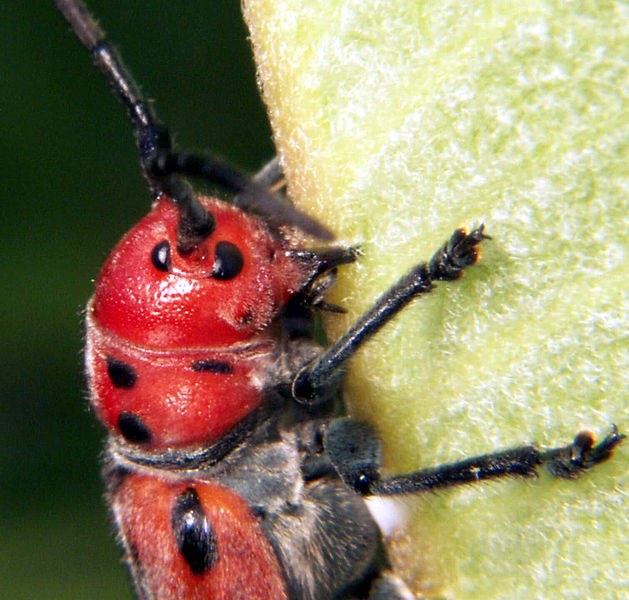Reproduction
 The Red Milkweed Beetle participates in sexual reproduction
during the early summer months of the year (Reinhartz, 2014).
What makes this organism different from most other arthropods is
that the males are more cautious when choosing a mate than the
females (Lawrence, 1986). Males demonstrate direct competition
and choice for mates, which is more unusual for arthropods.
There is more choosiness
over females with which to mate when there is an abundance of
females to choose from. In contrast, males become more
competitive when there are less females available to mate with
(Lawrence, 1986). Male Red Milkweed Beetles tend to be more
likely to end mating sessions than females, and many mating
sessions are terminated by other males wanting to mate with that
specific female (Droney, 2010). It has been proven that male
T. tetrophthalmus will
mate for a longer period of time and initiate mating sooner with
females who have physically larger bodies (Droney, 2010). The
bigger the female’s body is, the more larvae that can be
produced each day during the lifetime of that individual
(Lawrence, 1990). This is a major reproductive strategy; if a
female is large, she is more likely to pass on her genes. When a
female Red Milkweed Beetle mates more often, she produces more
fertile eggs than those who only mate once during their lifetime
(Lawrence, 1990). Females
show no specific size preferences towards the males they mate
with (Lawrence, 1986). Unlike many organisms, female Red
Milkweed Beetles do not use pheromones to attract mates
(Reinhartz, 2014). Male beetles simply fly to different milkweed
plants to find suitable mates. Each male and female will
typically mate multiple times with other mates during the mating
season. This is a major way to create genetic variation within
the Red Milkweed Beetle populations.
The Red Milkweed Beetle participates in sexual reproduction
during the early summer months of the year (Reinhartz, 2014).
What makes this organism different from most other arthropods is
that the males are more cautious when choosing a mate than the
females (Lawrence, 1986). Males demonstrate direct competition
and choice for mates, which is more unusual for arthropods.
There is more choosiness
over females with which to mate when there is an abundance of
females to choose from. In contrast, males become more
competitive when there are less females available to mate with
(Lawrence, 1986). Male Red Milkweed Beetles tend to be more
likely to end mating sessions than females, and many mating
sessions are terminated by other males wanting to mate with that
specific female (Droney, 2010). It has been proven that male
T. tetrophthalmus will
mate for a longer period of time and initiate mating sooner with
females who have physically larger bodies (Droney, 2010). The
bigger the female’s body is, the more larvae that can be
produced each day during the lifetime of that individual
(Lawrence, 1990). This is a major reproductive strategy; if a
female is large, she is more likely to pass on her genes. When a
female Red Milkweed Beetle mates more often, she produces more
fertile eggs than those who only mate once during their lifetime
(Lawrence, 1990). Females
show no specific size preferences towards the males they mate
with (Lawrence, 1986). Unlike many organisms, female Red
Milkweed Beetles do not use pheromones to attract mates
(Reinhartz, 2014). Male beetles simply fly to different milkweed
plants to find suitable mates. Each male and female will
typically mate multiple times with other mates during the mating
season. This is a major way to create genetic variation within
the Red Milkweed Beetle populations. 
After eggs within the female T. tetrophthalmus
have been fertilized by the sperm from one of her male mates,
she will lay her eggs at the base of the stem of a milkweed plant,
Asclepias syriaca
(Reinhartz, 2014). The female may also choose to insert her larvae
into a nearby stalk of grass. Approximately 10 to 15 eggs are
deposited from a female when she inserts them into the milkweed
plant (Matter, 2009). From the late summer months through the
winter, the larvae will hatch and utilize the roots of the milkweed
plant they were inserted into by their mother as a food source
(Reinhartz, 2014). During the late months of spring, the previously
larval T. tetrophthalmus
dig through the soil to emerge as adult Red Milkweed Beetles.
Throughout the summer months, the adult beetles mate, lay their eggs
in the milkweed plants, and then die during the fall months to
complete their lifecycle (Reinhartz, 2014).